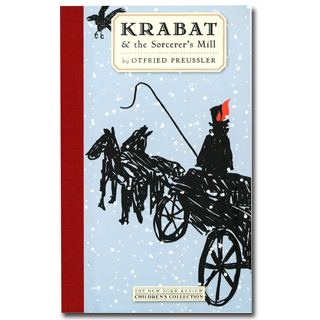
A FEW OTHER EVENTS FOR
SEPTEMBER 29:
- Happy birthday Marissa Moss (Amelia’s Notebook).
- It’s the birth date of Stan Berenstain (1923-2005), Berenstain Bears series.
- In 1916 John D. Rockefeller became the world’s first billionaire. Read John D. Rockefeller: Oil Baron and Philanthropist by Rosemary Laughlin.
- It’s National Attend Your Grandchild’s Birth Day. Read Zero Grandparents by Michelle Edwards and Grandparents Song by Sheila Hamanaka.
- It’s also National Coffee Day. Read The Bug in the Teacher’s Coffee and Other School Poems by Kalli Dakos, illustrated by Mike Reed, and All Because of a Cup of Coffee by Geronimo Stilton.
September is Library Card Sign Up Month, and I hope everyone who reads the Almanac has such a card. I personally owe the Westwood (MA) Public Library an invaluable debt; every book I have written would have been impossible without them.
For several years, our book of the day—Krabat & the Sorcerer’s Mill by Otfried Preussler—has been available only in libraries. But this month, the New York Review published this singular title in their children’s collection. First appearing in the United States in 1972 under the title The Satanic Mill, the book has long been considered one of the great German masterpieces for children of the twentieth century and has inspired writers such as Neil Gaiman and Cornelia Funke. Since it has never been as widely known in the United States as it deserves, I hope the new edition helps it reach its audience. Krabat was one of those books that changed the way I looked at the world; its imagery has haunted me for more than forty years.
Set in a vague and mysterious landscape, the book relates the story of Krabat, a fourteen-year-old beggar boy who travels from village to village singing carols in exchange for food. Soon, he is offered a position as a laborer in a mill. With a place to sleep and good meals every day, he finds his new home a relief and a blessing. But slowly Krabat begins to understand that by coming to the mill, he has made a pact with the devil. In one eerie scene, he tries to run away, but finds that all roads bring him back to the mill. Krabat begins to realize that practitioners of black magic can hold power over kings and empires; they can even make wars occur. But the death of Krabat’s best friend, and the circumstances surrounding it, leads him on a different path. Embracing love and the light, Krabat starts to fight the evil around him.
Much of the book depicts the mill workers’ daily lives, their pranks and pleasures. But between these simple interludes, Preussler explores the overarching theme that all humans must make a choice between following light or darkness. It is impossible for adults to read this post–World War II German novel without seeing its roots in the horrors of Nazi Germany. For children, the book is simply a thoughtful and yet entertaining exploration of some very serious questions. Consequently, the book makes an ideal read-aloud or book group choice, because it becomes richer when readers have a chance to talk about its content.
In a world beset by terrible events, I am grateful for Krabat & the Sorcerer’s Mill’s optimistic ending — it affirms that good can and will triumph over evil.
Here’s a passage from Krabat & the Sorcerer’s Mill:
The master had a fixed yoke outside the open door of the house; both ends were nailed to the door frame at shoulder heights. As the men came back they had to pass under it, one by one, saying, “I bow beneath the yoke of the Secret Brotherhood.”
The Master was waiting for them in the hall, and he gave each man a blow on the right cheek, with the words, “Remember you are my pupil!” Then he struck them on the left cheek, adding, “Remember I am the Master!” After that the men had to bow low to the miller three times, promising, “I will obey you in all things, Master, now and forever.”
Originally posted September 29, 2014. Updated for .












